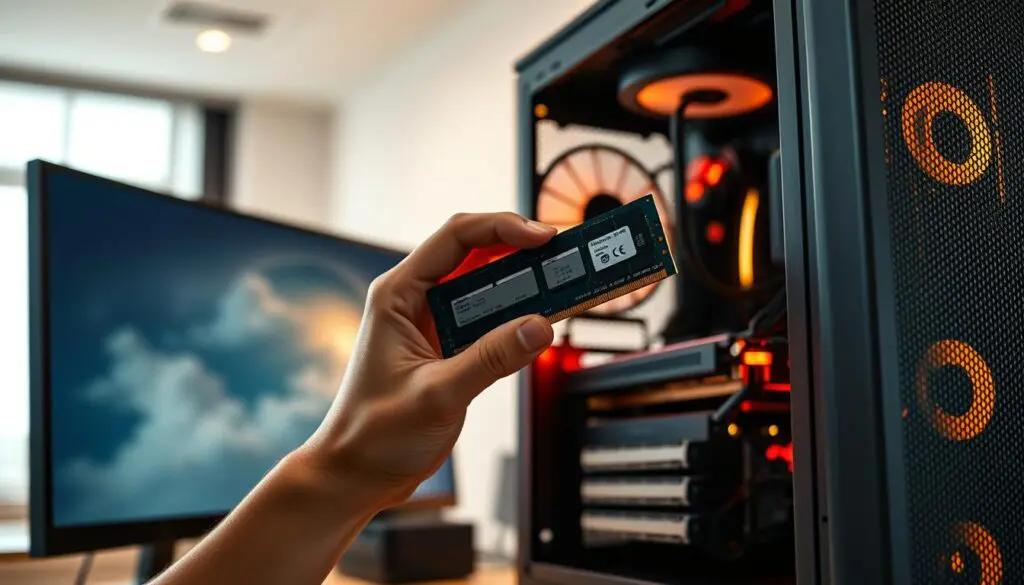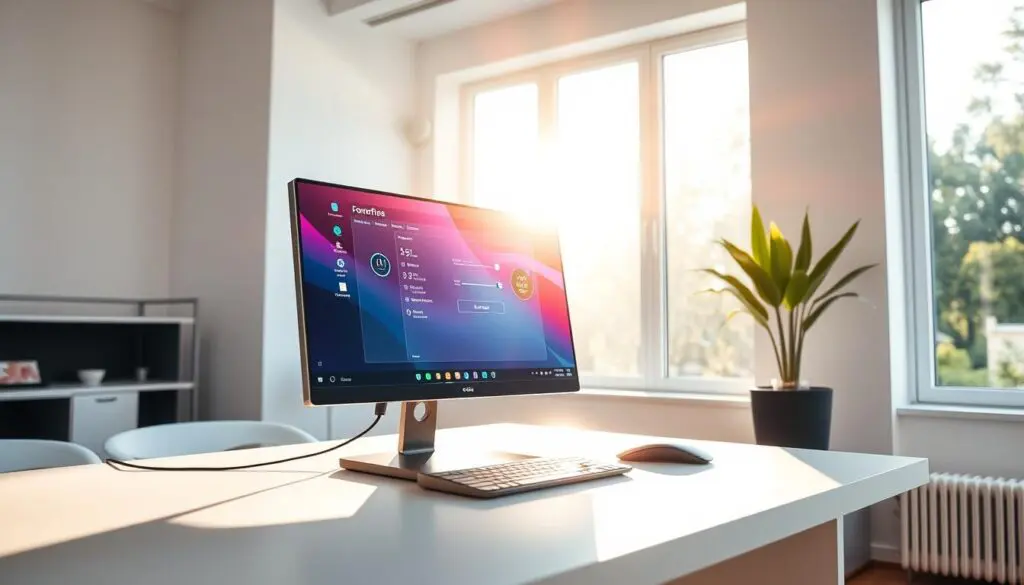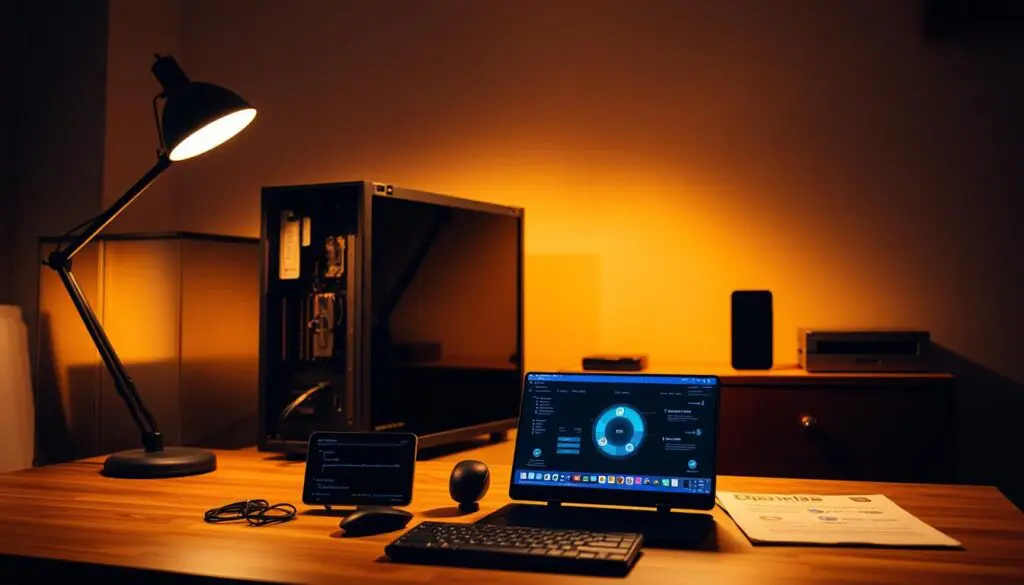Ever waited for your computer to start up, or seen simple tasks take forever? It’s a common frustration. But, you can make your slow PC faster with a few easy steps. By updating software or replacing hardware, you can improve your computer’s performance.
Key Takeaways
- Uninstall unnecessary programs to free up resources.
- Limit startup processes for a faster boot time.
- Perform regular disk cleanup and maintenance.
- Consider adding more RAM or installing an SSD.
- Adjust power settings for optimal performance.
Uninstall Unnecessary Programs to Free Up Resources
Many computers come with software you might not need. This extra software can slow down your device. To make your machine run better, it’s smart to regularly *opt to uninstall unnecessary software*.
Identify and Remove Crapware
Crapware, or bloatware, is software that comes pre-installed but is not useful. You can find and remove it through the Control Panel or Settings app.
- Open the Control Panel and navigate to Programs and Features.
- Look through the list for apps you don’t need.
- Choose the app to uninstall and click Uninstall to start.
Uninstall Unused Applications
As time goes on, you might have apps you don’t use anymore. These unused apps can make your system slow. By regularly checking and removing them, you can *optimize computer for speed*.
- Go to Settings and click on Apps.
- Look through the apps you have and find the ones you don’t use.
- Choose the app, then click Uninstall to get rid of it.
By doing these steps, you can *uninstall unnecessary software*. This frees up resources and makes your computer faster.
Limit Startup Processes for a Faster Boot Time
Reducing the number of programs that start with Windows can make your computer boot faster. Many apps start up without need, using up system resources. By controlling these settings, you can make sure only important programs start, boosting your system’s performance.
Disable Unnecessary Startup Programs
To speed up your computer, disable programs you don’t need. You can find these in the Task Manager. By letting only key apps start automatically, you reduce your system’s load at boot time. This makes your computer start up quicker and use resources better for other tasks.
Use Task Manager to Manage Startup Impact
The Task Manager is great for handling startup programs. Press Ctrl + Shift + Esc to open it. Then, go to the Startup tab to see programs that start at boot. Here, you can see which programs slow down startup and turn them off. Using the Task Manager makes your computer more responsive and efficient.
| Program Name | Status | Startup Impact |
|---|---|---|
| Windows Defender | Enabled | Low |
| Spotify | Disabled | High |
| OneDrive | Disabled | Medium |
| Google Chrome | Disabled | High |
Perform Regular Disk Cleanup and Maintenance
Keeping your PC in top shape is key. It’s all about regular care and smart tools to keep things running smoothly.
Run Disk Cleanup Utility
The Disk Cleanup tool on Windows is a great start. It helps get rid of old and unnecessary files. Just open the Start menu, type “Disk Cleanup,” and pick the drive you want to clean. Then, decide which files to delete to free up space.
Enable Storage Sense for Automatic Maintenance
Storage Sense is another handy feature. It automatically removes files you don’t need. This keeps your PC running well without you having to do much. To turn it on, go to Settings, then System, and Storage. Toggle Storage Sense to activate it.
Using these tips can really boost your computer’s speed. For more ways to make your PC faster, check out this resource.
Add More RAM to Improve System Performance
Adding more RAM can greatly improve your system’s performance. This is especially true for systems that are slow or need to handle many tasks at once. Upgrading your computer’s memory can make it run faster and more efficiently.
Choose the Right Type of RAM
It’s important to pick the right RAM type for your motherboard. For most laptops and desktops, DDR4 RAM is the best choice. But, older systems might need DDR3 or DDR2. Always check your motherboard’s specs before buying to avoid compatibility problems.
Also, make sure to know how much RAM your system can take. This will help you get the most out of your upgrade.

| Type of RAM | Generation | Speed Range (MT/s) | Best For |
|---|---|---|---|
| DDR4 | 4th Generation | 1600-3200+ | Modern PCs |
| DDR3 | 3rd Generation | 800-2133 | Older PCs |
| DDR2 | 2nd Generation | 533-800 | Legacy systems |
How to Install RAM in Your PC
Installing RAM is easy. First, turn off your system and unplug it for safety. Then, open the case and find the RAM slots on your motherboard. Press the clips at each end to open the slot.
Place the new RAM stick in the slot and press down until it clicks. Close the case, plug it back in, and turn it on. Handling components carefully and following static precautions can protect your equipment.
Install an SSD for Faster Data Access
Switching from a traditional hard disk drive (HDD) to a solid-state drive (SSD) can change your computer’s game. An SSD makes your computer start up and load things much faster. This makes your system more responsive and efficient. Let’s explore the benefits and how to upgrade HDD to SSD.
Benefits of Upgrading to an SSD
Upgrading to an SSD brings many benefits. First, SSDs access data much faster, cutting down on load times. They also use less power, which can make your laptop battery last longer. Plus, SSDs are more durable because they have no moving parts, making them less prone to damage.
How to Move Your OS and Apps to an SSD
Deciding to move your OS and apps to an SSD has two main paths: cloning or fresh install. Cloning software lets you copy your current system to the new SSD, avoiding the need to reinstall everything. Always back up important files before starting to avoid losing data.
| HDD | SSD |
|---|---|
| Longer boot and load times | Significantly faster boot and load times |
| Higher power consumption | Lower power consumption |
| Less durable due to moving parts | More durable with no moving parts |
Installing an SSD might seem tough, but the benefits are worth it. Once your OS and apps are on the SSD, you’ll see a big boost in your system’s performance.
How to Optimize Your Computer Performance by Changing Power Settings
Boosting your computer’s performance is easy with the right power settings tweaks. Adjustments can improve energy use and make your system faster and more responsive. Here’s how to do it:
Enable High Performance Mode
Turning on High Performance Mode makes your system run at its best. It focuses on speed over saving energy, perfect for demanding tasks. Even though it uses more power, the speed boost is worth it.

Adjust Power Settings in Windows
Windows lets you adjust power settings in many ways. You can change display brightness, sleep time, and how your processor works. These tweaks let you find the right balance between speed and energy use, making your computer better for you.
Run Built-in Troubleshooters to Identify Issues
Windows troubleshooters are key tools for fixing system problems. They help users find and fix computer issues quickly. These tools can spot many problems, like connection issues or slow system performance.
Using Windows Troubleshooters Effectively
To get the most from Windows troubleshooters, follow these steps:
- Navigate to the Update & Security section in Settings.
- Select the Troubleshoot tab.
- Choose the right troubleshooter for your problem.
- Follow the on-screen instructions to solve the issue.
Using these tools well can save you time. It also helps avoid needing a professional to fix your computer. This way, you can keep your computer running smoothly without hassle.
Conclusion
Improving your computer’s performance is a mix of hardware and software tweaks. Uninstalling unused programs frees up space. Limiting startup items makes your computer start up faster.
Regular disk cleanups and maintenance, along with adding more RAM, boost performance. Upgrading to an SSD makes data access quicker, speeding up your system.
Adjusting power settings and using built-in troubleshooters can fix slow spots. These tips help your computer last longer and work better. They make your computer faster and more efficient.
Keeping up with maintenance and upgrades lets you get the most out of your computer. By following these steps, your PC will stay fast and efficient. This approach makes your computer better for everyday tasks.
FAQ
How can I uninstall unnecessary programs to free up resources?
Look for and remove unused apps in the Control Panel or Settings app. This will help free up space and make your computer run better.
What steps should I take to limit startup processes for a faster boot time?
Use the Task Manager to turn off programs that start up automatically. Go to the Startup tab, see what each program does, and turn off the ones you don’t need.
How often should I perform regular disk cleanup and maintenance?
Clean up your disk every month. Use the Disk Cleanup tool to get rid of temporary files. Also, turn on Storage Sense for automatic cleaning.
How does adding more RAM enhance computer performance, and what should I consider?
More RAM means you can do more things at once and faster. Pick the right RAM type for your computer. Install it carefully to avoid damage.
What are the benefits of switching from an HDD to an SSD?
An SSD makes your computer start up and load things much faster. It also uses less power and lasts longer. You can move your OS and apps to the SSD.
Which power settings should I adjust to optimize computer performance?
Choose ‘High Performance Mode’ for better speed and performance. You can also adjust your screen’s brightness and how long it sleeps.
How do I run built-in troubleshooters to identify system issues?
Go to Update & Security in Settings. Then, click Troubleshoot and follow the steps to fix common problems.
CG Technologies – Managed IT Services Company
2499 Rutherford Rd #8
Concord, ON
L4K 0J9
